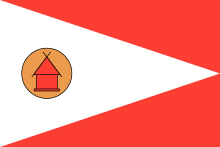 | |
 Merina girls | |
| Total population | |
|---|---|
| > 5 million[1] | |
| Regions with significant populations | |
| Madagascar | |
| Languages | |
| Malagasy and French | |
| Religion | |
| Christianity (Protestant, Catholic) syncretic with Traditional Religion[2] | |
| Related ethnic groups | |
| Betsileo; other Malagasy groups; Austronesian peoples, Bantu peoples |
The Merina people (also known as the Imerina, Antimerina, Hova, Borizany or Ambaniandro[3]) formerly called Amboalambo are the largest ethnic group in Madagascar.[4][5] They are the "highlander" Malagasy ethnic group of the African island and one of the country's eighteen official ethnic groups.[6][7] Their origins are mixed, predominantly with Austronesians arriving before the 5th century AD with Bantu Africans resulting in a core population known as Vazimba, later by large number of Javanese and a minority of Arabs, Indians and Europeans.[8] They speak the Merina dialect of the official Malagasy language of Madagascar.[8]
The Merina people are most found in the center of the island (former Antananarivo Province). Beginning in the late 18th century, Merina sovereigns expanded the political region under their control from their interior capital outwards into the island, with their king Radama I ultimately helping unite the island under their rule. The French fought two wars with the Merina people in 1883–1885 and in 1895, colonized Madagascar in 1895–96 and abolished the Merina monarchy in 1897.[8]
They built innovative and elaborate irrigation infrastructure and highly productive rice farms in high plateaus of Madagascar by the 18th century.[4] The Merina people were socially stratified with hierarchical castes, inherited occupations and endogamy,[9] and one or two of the major and long serving monarchs of the Merina people were queens.[10]
- ^ Jay Heale; Zawiah Abdul Latif (2008). Madagascar. Marshall Cavendish. p. 64. ISBN 978-0-7614-3036-0.
- ^ Rebecca L. Green (1997). Merina (Madagascar). The Rosen Publishing Group. pp. 20, 28–29. ISBN 978-0-8239-1991-8.
- ^ https://motmalgache.org/bins/teny2/ambaniandro
- ^ a b Merina people, Ethnic Groups of Madagascar, Encyclopædia Britannica
- ^ Anthony Appiah; Henry Louis Gates (2010). Encyclopedia of Africa. Oxford University Press. pp. 104, 167–168. ISBN 978-0-19-533770-9.
- ^ Bradt & Austin 2007.
- ^ Ogot 1992.
- ^ a b c John A. Shoup (2011). Ethnic Groups of Africa and the Middle East: An Encyclopedia. ABC-CLIO. pp. 180–181. ISBN 978-1-59884-362-0.
- ^ Cite error: The named reference
Campbell2005p120was invoked but never defined (see the help page). - ^ Cite error: The named reference
green20was invoked but never defined (see the help page).